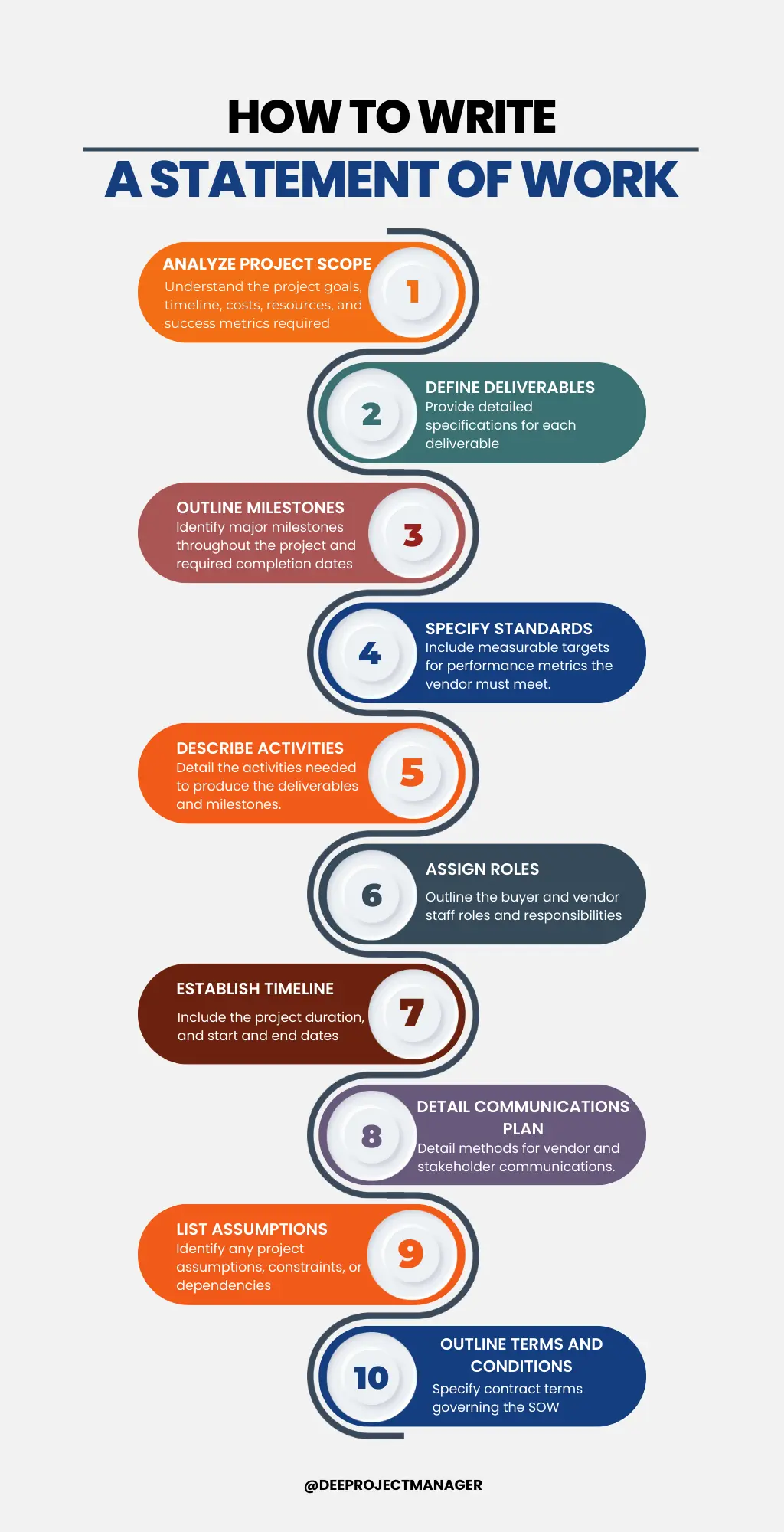When you’re managing a project that requires external sourcing from vendors or suppliers, or supplying goods and services, a procurement statement of work is integral for success.
This document provides critical direction for vendors outlining the key deliverables, timeline, quality standards, and more.
In this post, we’ll cover what a procurement statement of work entails, the types, and how to create one. We’ll also cover the difference between a statement of work in procurement and a contract.
What is a Statement of Work in Procurement?
A procurement statement of work (SOW) is a document in the procurement process that describes the scope of work a vendor must deliver on a project.
The SOW provides detailed requirements and expectations for the product, service, or deliverables that the supplier will provide.
The SOW serves as a binding agreement between the buyer and seller, outlining the activities, timeline, and quality standards to meet the project objectives. It provides clarity on roles, responsibilities, and performance metrics needed for project success.
An effective SOW outlines the required resources, major milestones, reporting requirements, acceptance criteria, and more.
It allows the buyer to clearly communicate expectations while enabling the supplier to understand the effort, skills, and timeline needed to fulfill the contract terms.
For complex projects, having a detailed SOW is essential for risk mitigation and establishing alignment between the buyer and vendor.

Importance and Purpose of the Statement of Work in Procurement
As a project manager, you should invest significant time into crafting a detailed, high-quality procurement statement of work (SOW) for any project involving external suppliers or vendors as it pays dividends throughout the project lifecycle.
There are several key reasons why the SOW is such an important document including:
Defines Scope and Deliverables
The SOW delineates the specific deliverables, timeline, and quality standards expected from the vendor.
It outlines the project scope and requirements in detail to ensure proper delivery.
Aligns Expectations
The SOW ensures alignment between the buyer and seller by clearly articulating expectations for deliverables, timelines, quality standards, reporting, and more which minimizes misunderstandings.
Reduces Risk
With an effective SOW, all stakeholders understand the scope, requirements, and acceptance criteria upfront which significantly reduces project risk and avoids potential disputes down the line.
Defines Metrics and Acceptance Criteria for Success
The metrics, KPIs, and acceptance criteria within the SOW provide clarity on what constitutes successful deliverable completion enabling objective evaluation.
Facilitates Resource Planning
The SOW allows the vendor to accurately estimate and plan the resources, costs, and effort needed to fulfill the contract and satisfy the buyer’s requirements.
Provides Legal Protection
The SOW forms part of the legally binding contract between the buyer and vendor. A clear, comprehensive SOW offers legal recourse if expectations are not met.
Clarifies Roles and Responsibilities
The SOW provides role clarity by outlining the division of labor between the buyer and vendor which prevents confusion and risks down the line.
Facilitates Project Planning
With a detailed SOW acting as a critical planning document, the vendor can accurately estimate costs, resource needs, and timelines required for the project work.

What are the Three Types of Procurement Statement of Work?
There are three primary types of procurement statement of work:
1. Design Statement of Work
A design SOW provides very detailed specifications for the deliverables. It outlines exactly how the vendor should execute the work, including required materials, measurements, tolerances, quality processes, etc.
The buyer assumes the risk if the instructions in the design SOW are inadequate. This type of SOW is commonly used for construction, manufacturing, or specialized equipment projects.
2. Performance-Based Statement of Work
A performance-based SOW defines the desired outcomes and results although it does not specify how the vendor should accomplish the work. It provides flexibility for the vendor to determine the best approach and methodology.
This style is well-suited to knowledge-based work where the process may vary, like IT services, consulting, or research. It shifts some risk to the vendor to ensure performance.
3. Level of Effort Statement of Work
A level of effort SOW focuses on the workload and resources required to complete the project, rather than the precise output. It is often structured around labor hours, material costs, or fixed fee payments.
This style works for ill-defined or ongoing projects. The buyer retains risk over how effectively labor and resources are utilized.
To choose the right type of procurement statement of work, consider the project complexity, level of buyer expertise, flexibility desired, and risk appetite.
The SOW must provide just enough specificity to ensure desired outcomes while allowing efficiency and innovation. Finding the right balance reduces project risk.
What Should be Included in a Procurement Statement of Work?
A comprehensive procurement statement of work (SOW) should include the following key components:
- Scope of Work: This section provides a detailed description of the deliverables, activities, and work to be performed by the vendor. Outline the project scope and objectives.
- Deliverables: Provide specifications for all deliverables including description, timeline, quantity, acceptance criteria, and quality standards. Be as specific as possible.
- Period of Performance: Define the timeline and schedule for deliverable completion, project milestones, overall contract duration, and required start and end dates.
- Place of Performance: Specify where the work must be performed, whether on-site, remotely, or a combination.
- Applicable Standards: List relevant industry standards, certifications, legal regulations, or organizational policies that apply.
- Acceptance Criteria: Outline objective pass/fail criteria for inspecting finished deliverables and milestones. Include required formats and metrics.
- Reporting Requirements: Detail frequency, methods, and audience for status updates, reports, and stakeholder communications expected from the vendor.
- Project Team: Identify key roles and responsibilities for buyer and vendor team members involved in the project.
- Payment Terms: Define compensation structure, rates, invoices, payment timeline, and total not-to-exceed amount for all contracted work.
- Performance Metrics: Include measurable targets for quality, cost, schedule, accuracy, or other key performance indicators.

how is the sow for a procurement developed?
Investing time upfront in developing a detailed, high-quality SOW provides the roadmap for procurement project success.
Follow these key steps to develop a SOW for a procurement:
- Analyze Project Scope and Requirements: First, thoroughly understand the project deliverables, timeline, costs, resources, and success metrics required. Analyze the end goals and objectives.
- Define Deliverables: Provide detailed specifications for each deliverable including description, acceptance criteria, quality standards, and timeline.
- Outline Milestones: Identify major milestones throughout the project and required completion dates. Milestones help track progress.
- Specify Performance Standards: Include measurable targets for cost, schedule, quality, accuracy, and other performance metrics the vendor must meet.
- Describe Required Activities: Comprehensively detail the activities, processes, equipment, and administration needed to produce the deliverables and milestones.
- Assign Roles: Define the division of labor between buyer and vendor staff roles and responsibilities, and outline the expected skill sets.
- Establish Timeline: Include the project duration, start and end dates, delivery schedules, and review cycles.
- Specify Communications Plan: Detail frequency, methods, and audience for vendor reporting and stakeholder communications.
- List Assumptions: Identify any assumptions, constraints, or dependencies that can impact project execution.
- Outline Terms and Conditions: Specify legal, payment, licensing, confidentiality, and other contract terms governing the SOW work.
Procurement Statement of Work Example/Sample
Statement of Work (SOW) for Company IT System Upgrade
1. Project Overview
This Statement of Work (SOW) is for JJ Owen Ltd, henceforth referred to as “the Company”, who is seeking to upgrade its existing IT system.
The objective of this SOW is to provide a clear and concise description of the work required from the selected vendor.
2. Scope of Work
The selected vendor will be responsible for the following tasks:
2.1 System Analysis and Requirements Gathering
- Review and understand the current IT system and infrastructure.
- Identify gaps and areas for improvement.
- Collect system requirements from stakeholders.
2.2 System Design
- Design a system architecture that addresses identified gaps and meets the gathered requirements.
- Prepare and present the system design to the Company for validation and approval.
2.3 System Implementation
- Install and configure the new IT system.
- Ensure seamless integration with the existing infrastructure.
- Validate the system functionality and performance.
2.4 Training and Support
- Train the Company’s IT staff on how to use, maintain, and troubleshoot the new system.
- Provide documentation for the system.
- Provide initial support and troubleshooting during the transitional period.
3. Deliverables
The selected vendor will deliver the following:
- A detailed report of the current system analysis and identified gaps.
- System design documents including diagrams and specifications.
- The upgraded IT system installed and fully functional.
- Training materials and system documentation.
- A report detailing the transition and any issues encountered and resolved.
4. Timeframe
The project duration is six months, starting from the date of contract signing.
5. Acceptance Criteria
Deliverables shall be considered accepted when they have been reviewed and formally approved by the Company’s designated project manager or stakeholder.
Note that this is a simplified example and the actual SOW can be much more complex, depending on the size and complexity of the project.
It’s also essential to involve legal and procurement professionals when creating an SOW to ensure all necessary points are covered and the company’s interests are protected.

Statement of Work vs Contract
The Statement of Work (SOW) and Contract are both crucial documents in project procurement management. They however have differences that are key to note:
As earlier iterated, a Statement of Work is a document that provides detailed information about the specific work to be done in a project.
It outlines the project’s objectives, the scope of the work, the tasks to be completed, the deliverables, the timeline, and the standards or benchmarks that will be used to measure the success of the project.
The SOW is typically a part of the overall contract between the client and the service provider. It plays a crucial role in managing expectations and ensuring that both parties have a clear understanding of what the project entails.
A contract, on the other hand, is a legally binding agreement between two or more parties. It includes the terms and conditions under which the work will be done and defines the legal relationship between the parties.
A contract typically includes the following:
- The parties involved in the agreement.
- The scope of the agreement, which might include the SOW.
- The financial terms, including the price and payment terms.
- The term or length of the agreement.
- The responsibilities of each party.
- The process for dispute resolution.
- Termination conditions.
- Confidentiality agreements or non-disclosure agreements (NDAs).
Key Differences Between a Statement of Work and Contract
While a SOW is focused on the “what” of the work (what needs to be done, when it should be done, and what the final deliverables should be), the contract covers the “how” of the work (how it will be done, who will do it, how much it will cost, and how disputes will be resolved).
The SOW is more about the project’s operational aspects, while the contract deals with the legal, financial, and administrative aspects.
That said, both documents are critical and complement each other in defining and managing the work, and both are necessary for a successful business relationship.
What is the Difference Between SOW and Services Procurement?
A Statement of Work (SOW) is a formal document that outlines the work, deliverables, timelines, and responsibilities of a specific project for a vendor or contractor.
Services procurement on the other hand refers more broadly to the overall process of sourcing and contracting professional services like consulting, marketing, or software development.
While an SOW is contained within a services procurement, it provides the project-level details and expectations.

Procurement Statement of Work PMP Exam Tips
Project procurement management is often a source of discomfort for project managers in the PMP certification exam.
This is because procurement may be handled in organizations different from what the PMBOK guide recommends.
Here are some tips for mastering PMP exam questions on SOWs:
- Know the key differences between the major SOW types – design, performance, and level of effort. Understand when each style is most appropriate.
- Be able to describe what key information is included in an SOW, such as scope of work, deliverables, timelines, quality standards, acceptance criteria, payment terms, etc.
- Understand the importance of developing a comprehensive, detailed SOW to set clear expectations between buyer and vendor. Know the risks of having an ambiguous or vague SOW.
- Recognize that the SOW should provide specifics on what the buyer needs, while allowing the vendor flexibility on how the work will be performed. Finding the right balance reduces project risk.
- Be able to compare and contrast the SOW vs the contract in areas such as purpose, detail level, flexibility, and dispute resolution. Know their complementary roles.
- Understand that the SOW provides the baseline for assessing vendor performance and milestone completion objectively based on the predefined metrics.
- Recognize the SOW plays a pivotal role throughout the procurement project lifecycle, from planning to closure. Invest time upfront to reap rewards later.
- Review SOW examples and templates to become more familiar with the structure, contents, and level of detail required. Drafting your own SOW can be great exam prep.
Conclusion
In summary, a procurement statement of work is a critical project management tool that outlines the required deliverables, timeline, quality standards, and acceptance criteria for a vendor.
An effective SOW clearly defines expectations, roles, and performance metrics to minimize misalignment and project risk.
It acts as the foundation for the legal contract and enables objective assessment of the vendor’s work.
For procurement projects large and small, investing time in detailing the statement of work pays dividends through increased clarity, reduced disputes, and higher quality results that set your project up for success.
FAQs
During Which Process is a Procurement Statement of Work Produced?
The Procurement Statement of Work (SoW) is typically produced during the ‘Plan Procurement Management’ process, a phase in the Project Management Body of Knowledge (PMBOK) guide’s procurement management knowledge area.
Who Writes the Statement of Work in Procurement?
The Statement of Work (SoW) in procurement is typically written by the project manager or the procurement manager, often with input from key stakeholders and subject matter experts to ensure accuracy and completeness.





